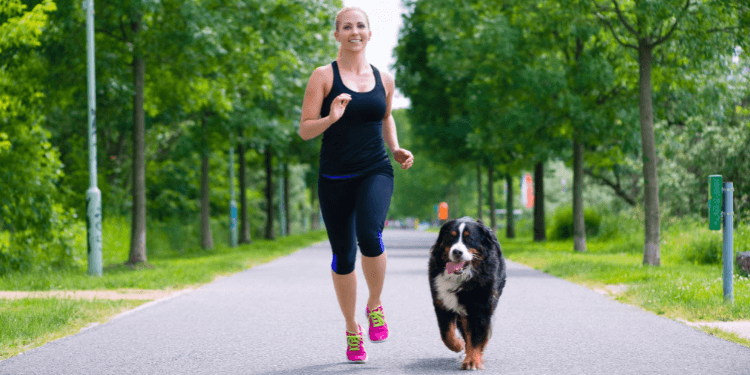Enlisting your dog as a workout buddy can have some serious perks. First of all, it’s much harder to skip a sweat session when your pup is looking up at you expectantly, ready to get out there and run. And, just like it does for you, daily exercise does wonders for your dog’s health and happiness.
So what’s the best way to get started? Here are essential do’s and don’ts for running with your dog.
Do: Check in with your vet
Even if your dog’s enthusiastic about running, your vet will help you assess whether they’re fit for regular runs. A dog’s health, build, breed, and age all factor in. Dogs with short legs, for example, may not be able to keep up with the pace you’d like to maintain. Older dogs or larger breeds could be prone to arthritis or hip dysplasia, an abnormal formation of the hip socket that can lead to arthritis. Even if you’re fairly certain your pup is fit to run, it’s still a good idea to check-in. Your veterinarian may also suggest a dietary change, for example, to account for the increase in activity.
Don’t: Start them too young
Running on hard surfaces can damage a puppy’s joints and bones that are still growing. The amount of time when a young dog’s growth plates (areas of cartilage near the ends of bones) start to close varies significantly from breed to breed. If you think your puppy is still growing, be sure to ask your veterinarian about when it’s safe to start running with them regularly.
Do: Be sure to warm-up
Instead of launching into a full sprint right off the bat, be sure to give yourself – and your dog – a proper warm-up to help you both avoid injury. Always start with a few minutes of walking or slow jogging. Giving your pup some time to sniff around and do their business in front of or near your house can also help avoid you needing to carry a full poop bag as you run.
Don’t: Move too fast
You wouldn’t expect a human who has led a previously sedentary lifestyle to hop off the couch and instantly run a marathon. The same goes for a sedentary dog. Whenever you begin running with your dog, start slow and short, and provide plenty of walking breaks along the way to let them catch their breath.
As you run, watch for signs of fatigue in your dog:
- Lethargy
- Weakness
- Drooling and dark red gums
- Vomiting
- Bloody diarrhea
- Panting to the point that they can’t catch their breath.
If your dog stops and refuses to continue, don’t force them. Instead, find some shade and offer some water – you can even dunk their head. Be patient and remember that just like humans, your dog’s strength and endurance will build over time with regular runs.
Do: Teach proper obedience
If your dog misbehaves on walks, they’re probably not ready to run with you. But that doesn’t mean they can’t learn! Start by teaching them basic commands such as “leave it” (so they’re not trying to sniff every tree on your run), plus “sit” and “stay” which can be helpful for stop signs, etc. If you’re having trouble, a dog trainer or obedience class can be a lifesaver.
Don’t: Forget the water
Since dogs can’t tell you when they’re thirsty, err on the side of offering more water than you think they need. Stopping every 10 minutes to offer water, especially on a hot day, will ensure your pup doesn’t get dehydrated. Be sure to carry a container your dog can drink from – collapsible bowls are a great lightweight option.
Do: Use the right leash
The ideal length for a leash when running with your dog is 4 to 6 feet. You want to train your pup to stay by your side, so anything longer than that can be troublesome. You can also purchase a waistband that lets you attach a leash for your dog to run in front of or next to you, leaving your hands free. Try the Kurgo RSG Active Utility Belt or the EzyDog Road Runner Hands-Free.
Don’t: Offer treats too soon
Just as eating a snack when you’re still huffing and puffing would make you feel sick, the same goes for your dog. Wait till they’ve had plenty of time to cool down and stop panting after your run before you offer any treats or food. In the meantime, praise them with plenty of attention and affection, showing them how much you love running with them. If you are going to give a treat you might as well make it a functional one. GlycanAid HA and Flexerna Omega are a great combo to keep your dog’s joints healthy and happy so you can have a running buddy for years to come.
Do: Have fun
Fun is what it’s all about. Stay in tune with your pup and ensure they’re having a good time on your runs together – a positive sign is if their tail wags excitedly when they see you in your running gear, reaching for their leash.
In the long run (no pun intended), running with your dogs provides you with the ultimate motivation partner and can be an extremely enjoyable and healthy habit for you both. Keep up the good work!











